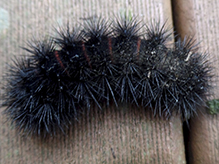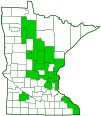Giant leopard moth
(Hypercompe scribonia)
Conservation • Description • Habitat • Ecology • Distribution • Taxonomy
| Hodges # | 8146 |
||
Conservation Status |
|||
| IUCN Red List | not listed |
||
| NatureServe | NNR - Unranked |
||
| Minnesota | not listed |
||
Description
Giant leopard moth is a common, large, easily recognized tiger moth. It is one of the largest tiger moths in eastern North America. Males are up to 2″ long with a wingspan up to 3½″. Females are much smaller, no more than 1¼″ in length.
The thorax is white with twelve bluish-black spots. There is a tympanal hearing organ on each side of the thorax, but this is covered with hairs and is not visible from above.
The abdomen is strikingly colored but not visible when the moth is at rest. It is bright orange above with large iridescent blue and black bands in the middle (dorsally) and a row of large iridescent blue and black spots on each side (laterally).
The forewings are white with numerous glossy bluish-black spots. The spots are highly variable. They may be solid, boldly outlined with a white center, or narrowly outlined and hollow. The outer portions of the forewing lose their white scales and become translucent as the moth ages.
The caterpillar is up to 3″ long and is densely covered with long stiff bristles (setae). The setae are sharply pointed and barbed. They are in clusters rising from prominently raised warts. A narrow, dull red ring between each abdominal segment is visible when the caterpillar moves or curls up into a defensive posture. There is a small breathing hole (spiracle) on both sides of each thoracic segment and all but the last abdominal segment. The spiracles are dull red.
Size
Male Total length: up to 2″
Female Total length: up to 1¼″
Wingspan: 2¼″ to 3½″
Similar Species
Habitat
Ecology
Season
One generation per year: May to June
Behavior
The caterpillar hides in leaf litter or under loose bark during the day and comes out at night to feed. When threatened, it will roll up.
Adults are active at night. Male adults are attracted to light. Females are not. When threatened, they will curl up, displaying their brightly colored abdomen, and exude a yellow, acrid-smelling liquid.
Life Cycle
Almost mature caterpillars overwinter under logs and beneath bark.
Larva Food/Hosts
Deciduous trees and a wide array of low growing herbaceous and woody plants.
Adult Food
Adults do not feed.
Distribution |
||
|
Sources 21, 24, 29, 30, 71, 75, 82, 83. Biodiversity occurrence data published by: Minnesota Biodiversity Atlas (accessed through the Minnesota Biodiversity Atlas Portal, bellatlas.umn.edu, 10/1/2025). |
|
| 10/2/2025 | ||
Occurrence |
||
Common in the United States east of the Great Plains |
||
Taxonomy
Order
Lepidoptera (Butterflies and Moths)
Superfamily
Noctuoidea (Owlet Moths and Allies)
Family
Erebidae (Underwing, Tiger, Tussock, and Allied Moths)
Subfamily
Arctiinae (tiger moths and allies)
Tribe
Arctiini (tiger moths)
Subtribe
Spilosomina
Genus
Hypercompe
Subfamily
Until recently, tiger moths and lichen moths were treated as a separate family Arctiidae. A recently published monograph (Lafontaine and Schmidt, 2010) contended that the Arctiidae “were more closely related to groups within the Noctuidae than to non-noctuid families.” The Arctiidae were transferred intact to the family Erebidae as a subfamily (Arctiinae). The former subfamilies are now tribes and the former tribes are now subtribes.
Subordinate Taxa
giant leopard moth (Hypercompe scribonia denudata)
giant leopard moth (Hypercompe scribonia scribonia)
Synonyms
Bombyx chryseis
Bombyx cunegunda
Ecpantheria confluens
Ecpantheria denudata
Ecpantheria scribonia
Hypercompe chryseis
Hypercompe confluens
Hypercompe deflorata
Hypercompe denudata
Phalaena oculatissima
Phalaena scribonia
Common Names
eyed tiger moth
fever-worm (caterpillar)
giant leopard moth
great leopard moth
Glossary
Seta
A usually rigid bristle- or hair-like structure on butterflies and moths used to sense touch. Plural: setae.
Spiracle
A small opening on the surface of an insect or arachnid through which it breathes.
Tympanum
An external hearing structure. In reptiles and amphibians, the circular, disk-like membrane that covers the ear opening. In insects, the membrane covering the air sac and sensory neurons. Plural: tympani.
Visitor Photos
Share your photo of this insect.
This button not working for you?
Simply email us at info@MinnesotaSeasons.com.
Attach one or more photos and, if you like, a caption.
Nicole Rojas-Oltmanns |
||
Found the caterpillar in the bog at Lake Bemidji State Park … |
||
 |
||
… and the moth in the lake where our oldest kid rescued and cleaned it up. Unfortunately, it could not fly. |
||
 |
 |
|
Becky Strohmeier |
||
Raspberry bush leaf, 1am |
||
 |
 |
|
 |
 |
|
Luciearl |
 |
Giant Woolly Bear |
MinnesotaSeasons.com Photos
|

Slideshows
Hypercompe scribonia (Giant Leopard Moth)
Allen Chartier

Visitor Videos
Share your video of this insect.
This button not working for you?
Simply email us at info@MinnesotaSeasons.com.
Attach a video, a YouTube link, or a cloud storage link.
Other Videos
Giant Leopard Moth Hypercompe scribonia
Anangke
Giant Leopard Moth Beautiful Ultra Macro.
Ray OfMinneapolis
Leopard Moth (Erebidae: Hypercompe scribonia) Dorsal View
Carl Barrentine
Leopard Moth (Erebidae: Hypercompe scribonia) Lateral View
Carl Barrentine
Giant Leopard Moth ( Hypercompe Scribonia ) in East Dallas Backyard
DoogieDownProd

Visitor Sightings
Report a sighting of this insect.
This button not working for you?
Simply email us at info@MinnesotaSeasons.com.
Be sure to include a location.
Nicole Rojas-Oltmanns
9/20/2025
Location: Lake Bemidji State Park
Found … and the moth in the lake where our oldest kid rescued and cleaned it up. Unfortunately, it could not fly.
Nicole Rojas-Oltmanns
6/19/2025
Location: Lake Bemidji State Park
Found the caterpillar in the bog at Lake Bemidji State Park…
D. Kirchmann
9/20/2022
Location: Harris, Chisago Co. MN
caterpillar found on zucchini leaf, about noon.
HSutton
10/2/2019
Location: Cass County
Found in a northern hardwoods forest on a woody shrub
Minnesota Seasons Sightings




